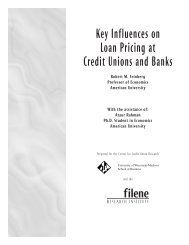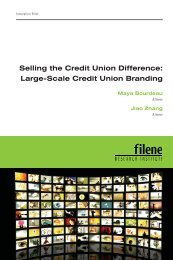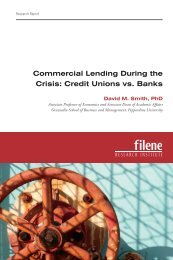Credit Union and Cooperative Patronage Refunds - Filene ...
Credit Union and Cooperative Patronage Refunds - Filene ...
Credit Union and Cooperative Patronage Refunds - Filene ...
Create successful ePaper yourself
Turn your PDF publications into a flip-book with our unique Google optimized e-Paper software.
ather than later, particularly if the member is a business entity that<br />
would pay income tax on the patronage distributions of income<br />
(cash <strong>and</strong> noncash) to members. The wisest approach would be to<br />
proactively manage expectations by educating members about what,<br />
exactly, they could expect from the credit union. We would have the<br />
same concerns about this scenario as we expressed for AgGeorgia<br />
earlier in this report. Each of the 27 credit unions in the Callahan<br />
study would have followed the co-op principles to the letter. Each<br />
dollar of patronage earnings would have been allocated to members<br />
just as those principles call for. On the other h<strong>and</strong>, by allocating<br />
every dollar of patronage earnings, these credit unions would<br />
also have overcommitted their capital, creating more obligations to<br />
redeem allocated equity than we could reasonably expect from any<br />
of the 27 credit unions, while also expecting each to retain capital to<br />
finance its normal growth <strong>and</strong> expansion.<br />
Allocate <strong>and</strong> Distribute 40% of <strong>Patronage</strong> Income<br />
Another strategy these 27 credit unions could adopt under Subchapter<br />
T is to allocate <strong>and</strong> distribute less than 100% of patronage<br />
earnings to members. For this section, we assume these credit unions<br />
each allocated 40% of their patronage earnings rather 100%. Comparing<br />
the Sub T: 100% with the Sub T: 40%, each $1.00 of income<br />
tax a credit union paid to federal <strong>and</strong> state governments, it would<br />
reduce its allocated equity redemption obligation by $1.70.<br />
While a strategy of allocating less patronage earnings <strong>and</strong> paying<br />
more income tax might be useful for Badgerl<strong>and</strong> to conserve its capital,<br />
or helpful for AgGeorgia to begin conserving more of its capital,<br />
it may not be as useful or helpful for any co-op taxed under Subchapter<br />
T whose members are only or primarily consumers, including<br />
credit unions. The taxation of the income of consumers who<br />
are unlikely to deduct the interest they pay to credit unions—other<br />
than interest they pay on mortgages—creates a dynamic that is quite<br />
distinguishable from the taxation of the income of businesses who<br />
deduct the interest they pay as a business expense.<br />
Recall that under Subchapter T patrons pay income tax on the entire<br />
distribution, both the cash <strong>and</strong> the allocated equity. All income—<br />
both cash <strong>and</strong> allocated equity—are reported on the 1099-PATR<br />
information return as income. Under either Sub-T scenario in<br />
Figure 6 above, however, for every dollar of patronage earnings<br />
allocated to a consumer, the consumer does not owe any income<br />
tax on April 15. The consumers’ expenditures at the credit union<br />
(other than mortgage interest) are not deductible. Consequently, the<br />
patronage earnings that are allocated are not income for the consumer<br />
even though a 1099-PATR was reported to the IRS. Even so<br />
the consumer receives a minimum of a 20% cash patronage refund,<br />
54








